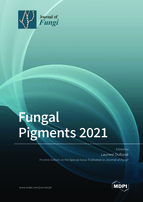Fungal Pigments 2021
A special issue of Journal of Fungi (ISSN 2309-608X). This special issue belongs to the section "Fungal Cell Biology, Metabolism and Physiology".
Deadline for manuscript submissions: closed (31 May 2021) | Viewed by 45345
Special Issue Editor
Interests: sustainable textile; microbial biotechnology; microbial production of pigments and colorants; fermentation; bioprocess engineering and fermentation technology
Special Issues, Collections and Topics in MDPI journals
Special Issue Information
Dear Colleagues,
Following the previous Journal of Fungi (ISSN 2309-608X) Fungal Pigments Special Issue edited and published in 2017, with 10 papers and the Fungal Pigments printed edition of 134 pages, the time has come to open a new edition entitled Fungal Pigments 2021 which will present the latest scientific advances in this field.
With the impact of globalization in research trends, the search for healthier lifestyles, the increasing public demand for natural, organic, and ‘clean labelled’ products, as well as the growing global market for natural colorants in economically fast-growing countries all over the world, filamentous fungi started to be investigated as readily available sources of chemically diverse pigments and colorants. For all of these reasons, this Special Issue of the Journal of Fungi will highlight exciting findings, which may pave the way for alternative and/or additional biotechnological processes for industrial applications of fungal pigments and colorants. Research papers and reviews about fungal biodiversity from terrestrial and marine origins are welcome, bringing new elements about fungi as potential sources of well-known carotenoid pigments (e.g., beta-carotene, lycopene) and other specific pigmented polyketide molecules, such as Monascus and Monascus-like azaphilones, which are yet not known to be biosynthesized by any other organisms, like higher plants. These polyketide pigments also include promising, and unexplored hydroxy-anthraquinoid colorants from Ascomycetous species. The investigation of biosynthetic pathways of the carotenoids and polyketide-derivative colored molecules (i.e., azaphilones, hydroxyanthraquinones, and naphthoquinones) in pigment-producing fungal species could bring some articles. Contributions about alternative greener extraction processes of fungal colored compounds, along with current industrial applications, description of their limits, and further opportunities for the use of fungal pigments in beverage, food, pharmaceutical, cosmetic, textile, and painting areas will also be part of this Special Issue.
Prof. Dr. Laurent Dufossé
Guest Editor
Manuscript Submission Information
Manuscripts should be submitted online at www.mdpi.com by registering and logging in to this website. Once you are registered, click here to go to the submission form. Manuscripts can be submitted until the deadline. All submissions that pass pre-check are peer-reviewed. Accepted papers will be published continuously in the journal (as soon as accepted) and will be listed together on the special issue website. Research articles, review articles as well as short communications are invited. For planned papers, a title and short abstract (about 100 words) can be sent to the Editorial Office for announcement on this website.
Submitted manuscripts should not have been published previously, nor be under consideration for publication elsewhere (except conference proceedings papers). All manuscripts are thoroughly refereed through a single-blind peer-review process. A guide for authors and other relevant information for submission of manuscripts is available on the Instructions for Authors page. Journal of Fungi is an international peer-reviewed open access monthly journal published by MDPI.
Please visit the Instructions for Authors page before submitting a manuscript. The Article Processing Charge (APC) for publication in this open access journal is 2600 CHF (Swiss Francs). Submitted papers should be well formatted and use good English. Authors may use MDPI's English editing service prior to publication or during author revisions.
Keywords
- Filamentous fungi
- Pigment
- Colorant
- Carotenoid
- Polyketide
- Azaphilone
- Anthraquinone
- Melanin
- Sclerotiorin
- Bikaverin
- Azulene
- Riboflavin
- Naphthoquinone
- Biodiversity







